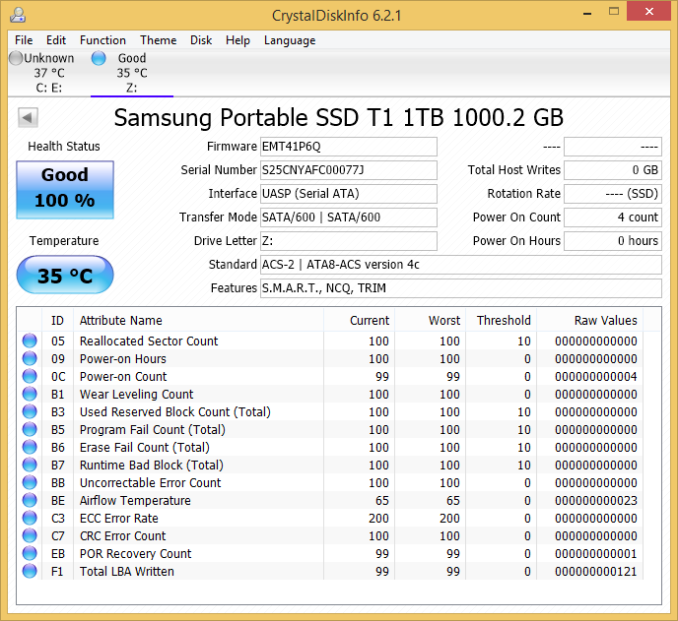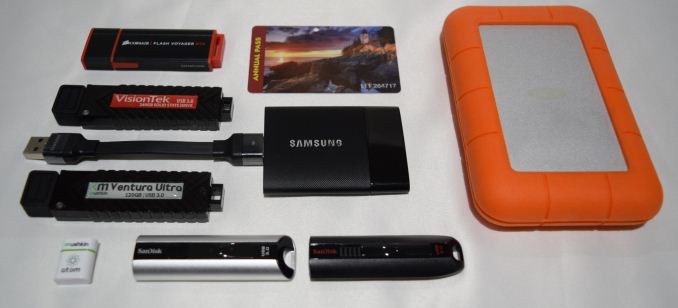Samsung Portable SSD T1 Review
by Ganesh T S on January 20, 2015 10:00 AM EST
Introduction and Testing Methodology
The last few years have seen rapid advancements in flash technology and the rise of USB 3.0 as an ubiquitous high-speed interface on computers. These have led to the appearance of small and affordable direct attached storage units with very high performance for day-to-day data transfer applications. We have already looked at some flash drives with SSD controllers and a USB 3.0 - SATA bridge over the last couple of months. These include the Corsair Flash Voyager GTX 256GB using the Phison S9 controller and the Mushkin Ventura Ultra using the SandForce SF2281 controller respectively.
At CES 2015, Samsung introduced the Portable SSD T1. With the introduction of the T1, Samsung becomes the first tier one manufacturer to enter the external SSD market (if you discount SanDisk's Extreme PRO USB 3.0 flash drives, which, despite being a SSD behind a USB 3.0 - SATA bridge, was never advertised as one). Hardware wise the T1 is based on the 850 EVO, meaning that the T1 uses 32-layer TLC V-NAND and the same full-fledged MEX/MGX SSD controller. CrystalDiskInfo gives us further insight into the unit.
Even though CrystalDiskInfo reports TRIM as a feature, we were unable to get it to work through the bridge configuration. In any case, Samsung also doesn't make any claims about TRIM support. S.M.A.R.T data was not visible to most of the commonly used tools. On the USB 3.0 side, the drive supports UASP (USB-attached SCSI Protocol) that should provide increased performance for sequential transfers. Claimed transfer rates are 450 MBps for sequential accesses and 8K read IOPS / 21K write IOPS. We also have hardware-accelerated AES-256 encryption.
Our review unit was pre-formatted in exFAT. Upon connecting to our testbed, a 128 MB FAT32 partition popped up and provided directions for installing the software / service that allows for the drive to be monitored / utilized with encryption capabilities. After installation, the 128 MB partition disappeared, and the 1 TB volume was made visible. The Samsung SSD program / daemon continues to run in the background and allows for altering the security option (encryption) without reformatting the partition. The gallery below shows the UI of the software running on Windows 8.1 Pro.
Testbed Setup and Testing Methodology
Evaluation of DAS units on Windows is done with the testbed outlined in the table below. For devices with USB 3.0 connections (such as the Samsung Portable SSD T1 that we are considering today), we utilize the USB 3.0 port directly hanging off the PCH.
| AnandTech DAS Testbed Configuration | |
| Motherboard | Asus Z97-PRO Wi-Fi ac ATX |
| CPU | Intel Core i7-4790 |
| Memory | Corsair Vengeance Pro CMY32GX3M4A2133C11 32 GB (4x 8GB) DDR3-2133 @ 11-11-11-27 |
| OS Drive | Seagate 600 Pro 400 GB |
| Optical Drive | Asus BW-16D1HT 16x Blu-ray Write (w/ M-Disc Support) |
| Add-on Card | Asus Thunderbolt EX II |
| Chassis | Corsair Air 540 |
| PSU | Corsair AX760i 760 W |
| OS | Windows 8.1 Pro |
| Thanks to Asus and Corsair for the build components | |
The full details of the reasoning behind choosing the above build components can be found here.
Samsung Portable SSD T1 - Size Comparison (standard credit card size also pictured for a frame of reference)
The list of DAS units used for comparison purposes is provided below.
- Samsung Portable SSD T1 1TB
- Corsair Voyager GTX 256GB
- LaCie Rugged Thunderbolt 500GB
- Mushkin Atom 64GB
- Mushkin Ventura Ultra 120GB
- SanDisk Extreme 64GB
- SanDisk Extreme PRO 128GB
- VisionTek Pocket SSD 240GB


















68 Comments
View All Comments
Kristian Vättö - Tuesday, January 20, 2015 - link
It refers to ALL kinds of NAND. For NAND that is used in client applications, the spec states that the data retention must be one year after the rated P/E cycle count has been reached. For enterprise applications, that time is three months. Whether it's SLC, MLC or TLC it doesn't matter -- they are all rated based on the same rules.What you have heard about 15nm is incorrect. Even 15nm TLC will adhere the same JEDEC specifications. What it may have is lower P/E cycle count in order to achieve 1-year data retention, but otherwise it's no different.
NAND is non-volatile, which means that it will retail its charge even without power. The charge is stored in a floating gate (or in a charge trap in V-NAND's case) that is surrounded by insulators, which will keep the charge in the FG even when power is off.
AJSB - Tuesday, January 20, 2015 - link
You say that for client applications is 1 year of DATA retention but for enterprise applications is only 3 months ?!?Shouldn't be the other way around ?!?
AJSB - Tuesday, January 20, 2015 - link
OK, i just read some charts of this doc in PDF:http://www.jedec.org/sites/default/files/Alvin_Cox...
...and CLEARLY DATA RETENTION depends a lot of at what temperature SSD works and at what temperature is SSD off....DATA retention can be as bad as ONE Week.
Granted, that is a worse case scenario, but i won't trust anything above 6 months ,,,check page 27.
Then, we have to ask ourselves, after reconnect drive in that time frame, how much time it takes for build-in controller recover cells charge and any power loss during that cells recover won't mess up the process.
ArsonW - Tuesday, January 20, 2015 - link
"...DATA retention can be as bad as ONE Week"Hey everyone, we have a mechanical HDD fanboy overhere! He tripped on his laptop cord and it still works...SSDs must be BAD!
Kristian Vättö - Wednesday, January 21, 2015 - link
Sure, but the data retention of a hard drive isn't any better if you throw it into a furnace. 55°C isn't a realistic room temperature in any case, even 30°C is higher than what most people prefer (might be regional differences, but at least here in Finland ~23°C is pretty average).Even then, that is the data retention AFTER the rated P/E cycle count has been reached. In the case of TLC V-NAND, that's 2,000 cycles. That works out to be 512,000GiB of writes for the smallest 250GB model, which translates to 280.5GiB of writes per every single day for five years. Once again, not a very realistic scenario.
AJSB - Wednesday, January 21, 2015 - link
Yes, at 55C nothing survives for long, be it SSDs or HDDs.Its also unrealistic, this is why i talked about 6 months.
BTW, here in Summer we go easily to 40C at shadow, that's why my concern.
For HDDs there is a program that refreshes magnetism in all sectors in some hours, such a thing is not as simple/possible in a SSD, however, i believe that Samsung 850 series should be one of the most reliable SSDs in the market because the way the cells are designed and its lithography gone back up to 40nm.
MikhailT - Tuesday, January 20, 2015 - link
You might want to go back to read your "sources" or read the actual specs. I believe you are truly confused as to what you're talking about and must be thinking of something else.2kfire - Tuesday, January 20, 2015 - link
My laptop has an SSD in it. I regularly throw it on the couch, dinner table, bed, floor, wherever, while it's running and I've never, EVER though "uh-oh, it's done!". Why? Because no moving parts, so nothing to "done". The laptop is an 8540 Elitebook, so nothing to "done" there either. :)I bumped a bare 2.5" mechanical while cloning an SSD to it one time. It moved maybe 2" and landed on my desk (I had it on top of a 3.5" HDD). It got the click of death, so I turned it into a fridge magnet.
AJSB - Wednesday, January 21, 2015 - link
Bumping a bare 2.5" is not the same as bumping one inside a notebook....the impact is bigger and like i said, not all drives are the same, it all depends of quantity, quality and type of sensors that a particular drive uses, like i said , not all drives are the same.In 20 years i didn't had a HDD failure...just like i didn't had a USB Flash Pen Failure...SD cards OTOH...i prefer not tell my horror stories with those cards :(
2kfire - Wednesday, January 21, 2015 - link
Believe me, I've bumped bare SSDs too. Again, I don't care with them because there's nothing to go wrong. It's barely worth mentioning, but at the same time the mechanical dropped 2" and died, while trying to catch it I knocked the SSD I was cloning off my desk and it hit the wall, still hanging off the cable. Nothing happened to it... The wall got a small nick.Point is, mechanicals have spinning disks and floating heads that are actually quite delicate. SSDs have chips that are soldered on. They're not nearly as delicate.